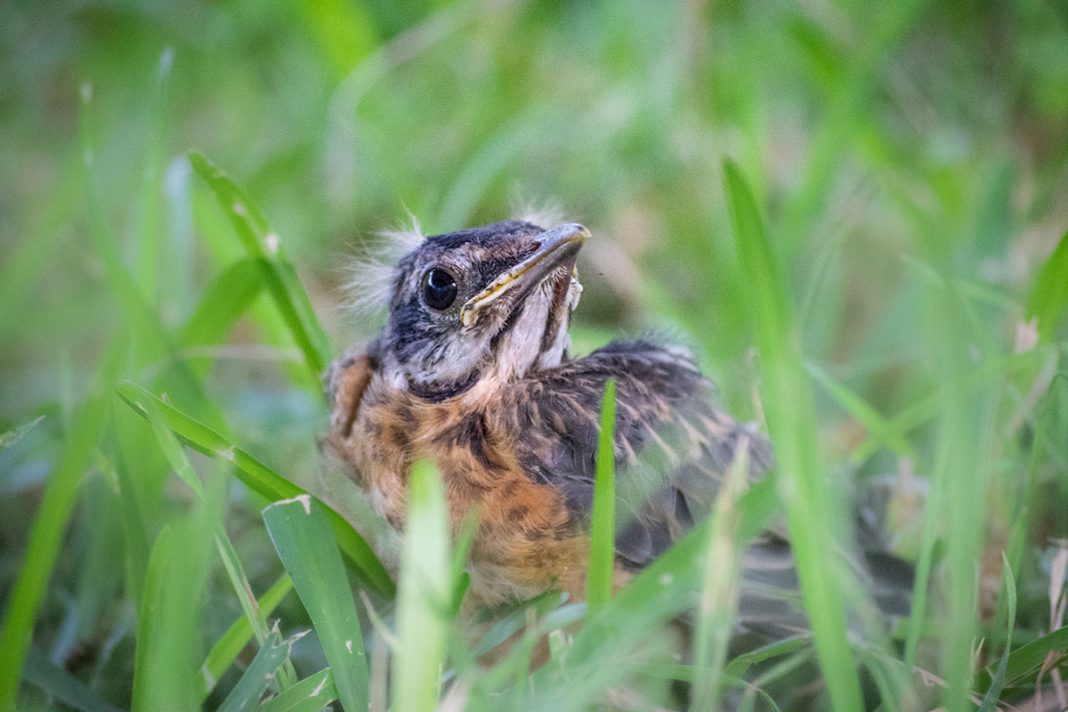Spring is once again in the air, and baby animals and baby birds will soon be all around us. Understanding natural behavior is important as it can save wildlife lives. Sometimes well-meaning individuals think they are helping or saving baby animals from harm when, in fact, they are taking healthy babies away from their wild parents. Understanding the natural behavior about how baby birds grow and leave the nest can help to prevent them from being needlessly kidnapped.
Some of the large birds of prey in our area, such as eagles and great horned owls, begin nesting as early as December/January, so chicks may hatch out by January/February. The largest raptors nest earlier and then the smaller raptors nest later into the spring and early summer. Songbirds begin choosing nesting sites as early as February and may begin laying eggs in March. This means there are several times throughout the year when baby birds will be hatched and raised, with baby birds leaving their nests sporadically throughout the warmer months.
Raptors (hawks and owls) are typically born anywhere from January through May. Generally, the larger the bird the earlier in the year they are born. By May, many of the early arrivals are beginning to leave their nests. Similar to songbirds, when raptors first leave the nest, they cannot fly well yet. They are called “branchers” at this age and sometimes they wind up on the ground inadvertently. If they have feathers as opposed to down and they are in a safe location, they should be left alone. Their parents will still attend to them while they learn to fly. If you are not certain whether a baby owl or hawk may need help, please call us for assistance. Sometimes even younger birds that have fallen from nests can be “re-nested” in a large basket so their parents can continue to care for them.
Songbirds are busy nesting in spring and summer, and some birds will even raise two or three broods each season. Hatchling birds have no feathers. Nestling birds have fuzzy down feathers and/or are just beginning to have pin feathers emerge (it looks like they have toothpicks sticking out of them). If either a hatchling or nestling and has fallen from a nest, it does need help. If you can place it back in the nest, that is the best thing to do (it is an old wives’ tale that touching the baby will cause the parents to reject it). If the nest has been destroyed or cannot be located, take a small basket or bowl (like a margarine container), punch some holes in the bottom, and line it with pine needles, leaves, or straw. Tack the nest on the tree closest to where you found the baby and watch for at least a couple of hours to see if the parents come back to feed. Fledgling baby birds are fully feathered and have about one inch of tail feathers. They leave the nest TO learn how to fly, not WHEN they can fly. It is normal for them to hop from branch to branch or even wind up on the ground. The parents will still tend to them while they learn to fly. If they are in danger from domestic pets or not in a safe spot, it is ok to pick them up and place them in a nearby bush or low tree. This is the most dangerous time for baby birds, but they just need a day or two before they can fly quite well. If possible, keep cats indoors if you notice fledgling birds in your area.

Friends of Texas Wildlife will be having an Open House on Saturday, March 21 from 11 am to 3 pm. At this open house, we will have many interesting educational displays. All our educational animals will be there for you to visit with (opossum; box turtles; snake; owls; and hawks). Educational displays will also be presented by: The Spring Creek Greenway Nature Center; Texas Master Naturalists; Texas Wildlife Association; Caleb Paul (snake wrangler/reptile rescue and removal); Montgomery County Sheriff’s Office; Lake Houston Nature Center; Texas A & M Forest Service. For the first time ever, we will be offering “behind the scenes” tours of our flight enclosures and intake center. This is the only time this year our entire facility will be open to the public. $5 per person, kids 3 and under free. More details available at www.ftwl.org. To learn more about what we do and view pictures of many of the animals we assist, please visit our Facebook page at www.facebook.com/SavingTexasWildlife. Our educational visitor’s center is open the second Saturday of each month from 10 a.m. to 2 p.m., located at 29816 Dobbin Hufsmith Road, Magnolia, Texas, so the next open house date will be Saturday, March 14. Come on out and visit us, learn a little more about local wildlife, do some fun activities and a craft, and meet some of our non-releasable wildlife educational animals. We also host birthday parties, camps, and educational presentations. For more information about events, birthday parties, spring break camps, summer camps, or educational presentations for scouts, schools, or other groups, please visit our website or email [email protected]. There are many other ways you can help support our efforts, too (such as Kroger Community Rewards, Amazon Smile, etc.). Details can be found at www.ftwl.org, and then click on “How to Help”.















